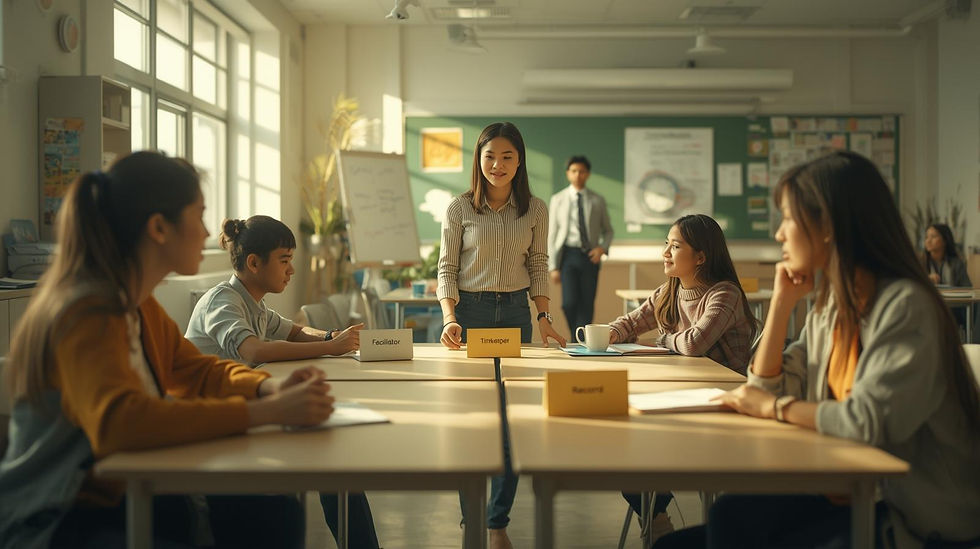🌱 From Teacher-Led to Student-Led: How to Build Agency in the Classroom
- vanessa speigle
- Oct 7
- 6 min read
The classroom was silent........finally.
But then I realized......maybe it was too silent.
Every eye was on me, waiting for the next instruction.
And in that moment, it hit me...........they weren’t thinking.
They were waiting to be told how to think.

I finally had my quiet moment to “teach more,”
but now I know I needed to talk less.
That’s when I stopped asking for answers and started asking for ideas.
The energy shifted.
One student raised her hand and asked, “Can we try it our way?”
That’s when leadership was born. 🌿
That’s the shift from teacher-led to student-led learning and it’s not chaos. It’s agency in action.It’s also the heartbeat of Finnish pedagogy, where learning begins with trust and grows through collaboration.
🌿 Let’s Remember: What Makes a Finnish Classroom Different

Before we move forward, let’s pause and remember what truly defines a Finnish-inspired classroom. These ideas aren’t new but they’re worth revisiting, because mastery in teaching comes not from novelty, but from reflection.
A Finnish classroom begins with trust, not control. Students don’t have to earn it, they start from it. When we believe in their capacity to act responsibly, they begin to live up to that belief. A small shift, like offering choice in how students demonstrate their understanding perhaps a drawing, a short talk, or a written piece, quietly communicates, “I trust your way of thinking.”
From there, the teacher’s role changes. In Finland, teachers don’t direct the play, they facilitate the learning. They design the flow, the environment, the conditions for curiosity, and then they step back to let discovery happen. Instead of saying, “Here’s how to do it,” they ask, “What do you notice?” or “Who sees it differently?” These open doors invite students to think for themselves, to take intellectual risks, and to grow in confidence.
Reflection then becomes the heartbeat of the classroom. Students aren’t just completing activities, they’re learning to observe themselves as learners. A few quiet minutes at the end of each lesson to ask, “What surprised me today?” or “Where did I help someone else learn?” transforms learning into a conversation about growth. In Finland, that reflection is more than closure, it’s assessment in action.
And all of this unfolds inside a culture of collaboration rather than competition. Success is shared. Students learn side by side, building not only skills but empathy. When one student leads a discussion and another takes notes or manages time, both are practicing leadership, just in different ways. The focus shifts from “Who finished first?” to “What did we build together?”
When trust, facilitation, reflection, and collaboration come together, a calm rhythm fills the room, one where students feel capable, seen, and safe to lead. 🌿
🌼 New Insights from Finnish Classrooms
Now that we’ve revisited the foundations, let’s go deeper. What happens after trust, reflection, facilitation, and collaboration take root? How do we move from teacher-led to student-led classrooms? Here are three practices that help Finnish teachers, and now, us, grow even further.
🌤 Give Feedback That Grows, Not Grades That End

Why it matters: In Finland, feedback is formative, ongoing, and focused on progress not perfection. Students see learning as a journey, not a score.
Step-by-step classroom practice:
Observe the process, not just the product. Watch how students approach a task before you comment.
Use the “3-Part Feedback Talk”:
“I noticed…” (specific observation)
“You seem proud of…” (invite ownership)
“What if you tried…” (offer a forward step)
Schedule short feedback moments mid-lesson instead of waiting for the end, quick two-minute check-ins build consistency.
Low-resource alternative: Use sticky notes or a “Feedback Wall.” Students and teachers add short notes beginning with “I noticed…” or “Next time…”
🎯 Reflection: How can you make feedback part of the learning flow instead of an afterthought?
🌿 6. Make Well-Being Visible

Why it matters: Finnish education treats calm and balance as conditions for learning.Well-being isn’t a break from learning, it’s what makes deep learning possible.
Step-by-step classroom practice:
Start with a reset. Begin every class with a “quiet minute” — students breathe or stretch while you softly say, “Let’s arrive together.”
Plan micro-pauses. After 15–20 minutes of work, pause for a 60-second movement or “laugh break.”
Close with gratitude. Ask, “What was one moment that made you feel good about learning today?”
Low-resource alternative: Use natural pauses: transitions, line-ups, waiting moments, as opportunities for breathing or simple mindfulness.
🎯 Reflection: What routines in your classroom model balance rather than burnout?
🌍 7. Think Beyond Subjects - Phenomenon-Based Learning
Why it matters: Finnish classrooms merge subjects through real-world phenomena.This helps students see connections and understand that knowledge is integrated, not isolated.

Step-by-step classroom practice:
Choose a theme. Pick one phenomenon relevant to your community e.g., Water, Transport, Food, Friendship.
Design an inquiry question together. Example: “How does water connect our lives?”
Map subject links:
Science → water cycle
Art → painting waves
Geography → local rivers
Language → writing water poems
Let students share discoveries in any format: poster, model, or mini-talk.
Low-resource alternative: Use local materials: soil, maps, photos, instead of tech tools. Invite a community member (gardener, bus driver, parent) for a short talk to ground the theme in real life.
🎯 Reflection: How might one real-world theme weave your subjects together next week?
🌱 Moving from teacher-led to student-led; 3 Steps to Begin the Shift
This final section helps you translate these ideas into immediate, tangible action. Whether you teach preschool or secondary, these steps can fit any schedule, any class size, and any resource level.
🌿 1. Add One Student Choice This Week
Why it matters: Choice communicates trust and builds intrinsic motivation. Even a single decision creates ownership, a key principle of Finnish education.

Step-by-step classroom practice:
Pick one upcoming activity: a discussion, art task, or reading response.
Offer two or three pathways to complete it (e.g., drawing, writing, or acting it out).
Allow students to share why they chose their method, this reflection deepens awareness.
Celebrate the process, not the uniformity.
Low-resource alternative: Use quick verbal choice cues: “You can show your answer by drawing or explaining.”
🎯 Reflection: After offering choice, notice: did engagement rise? Did quiet students participate more?
🌸 2. Try One Reflective Exit Question
Why it matters: Reflection turns experience into growth. It also replaces grades with self-assessment, a hallmark of Finnish formative feedback.
Step-by-step classroom practice:
Reserve 3–5 minutes at the end of class.
Post one reflective prompt on the board:
“What challenged me today?”
“What will I do differently next time?”
Let students write in journals, share in pairs, or drop anonymous notes into a “Reflection Box.”
Review a few aloud at the start of the next class to close the feedback loop.
Low-resource alternative: Use oral reflection: a short “Turn and Talk” works just as well as journals.
🎯 Reflection: How does your class energy shift when students pause to name their own growth?
🌼 3. Build One Calm Routine
Why it matters: Calm minds learn faster and Finnish classrooms intentionally design calm transitions to prevent fatigue.

Step-by-step classroom practice:
Choose one daily transition that often feels rushed such as when students enter the classroom in the morning, return from recess, or finish a lesson and turn it into a calm ritual instead.
Introduce a two-minute calm practice: soft instrumental music, deep breathing, or a short story read aloud.
Keep it consistent repetition signals safety and resets focus.
Invite students to co-lead the calm moment over time.
Low-resource alternative: Use nature sounds from a phone, soft humming, or a student-led breathing count (in for 4, out for 4).
🎯 Reflection: How does the energy of your classroom change when you pause together before beginning?
🎥 Continue the Journey - Watch the Kickoff Video
This week’s theme, Leadership in Learning, began on Sunday with our latest YouTube episode:🎥 “Leadership in Students: How Play Grows Confidence, Collaboration and Voice.”
In that video, we explored how trust, play, and collaboration form the roots of leadership for students and teachers alike. Today’s blog builds on that same idea: when we hand over responsibility, students begin to grow their own leadership branches. 🌿
👉 Watch the video here and reflect on how play and trust shape the way your students learn to lead.
🌱 Rekla Reflection Question
How might you hand over one small piece of control this week and watch leadership grow?

👩🏫 Rekla Resource
Student Leadership Bundle Hands-on lessons that nurture voice, trust, and agency through peer reflection and collaborative design.🪴Available by grade level: Gr 1-2, 3-5, 6-8, 9-12.






Comments